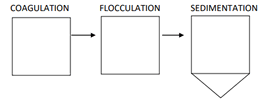Chemical Wastewater Treatment
Groundwater and surface water has contained dissolved and suspended colloids. Coagulation are used to separate dissolved and suspended colloids from the water. Chemical coagulation and flocculation process has three steps. Chemical wastewater treatment is widely used in industrial wastewater treatment plants.
- Coagulation
- Flocculation
- Sedimentation
Size of colloids is between 1 nm and 0.1 nm. To make higger than this size, it should be added Chemicals, which generally uses Alum, Ferric sulfate, Ferric chloride. Chemical coagulation accelerate sedimentation process. The precipitation of colloids is realized by chemical addition. The addition chemicals ensure that colloids come together to make size of colloids and sedimentation for better.
Al2(SO4)3 * 18H2O + 3Ca(OH)2 ----> 3CaSO4 + 2Al(OH)3 + 18H2O
Fe2(SO4)3 + 3Ca(HCO3)2 ----> 2Fe(OH)3 + 3CaSO4 + 6CO
The chemical added to the water to be treated is mixed with the water by rapid mixing. For this process time required between 2 – 5 minutes.
The next step after the rapid mixing process is flocculation. Suspended solid materials and wastewater pass into the flocculation tank after rapid mixing with rapid mixers. Fort his process time required between 15 – 45 minutes. Velocity should between 0,6 – 0,9 m/s in order to keep the flocculation. Slow mixers are used for flocculation process.
Sedimentation process of chemical wastewater treatment is coming after slow mixing. During precipitation, the bubbles are separated from the liquid so that the solid liquid structures are separated from each other. For this process time required between 2 – 4 hours.

Chemical treatment can be done in mobile package containerized chemical treatment plants or in reinrorced concrete tanks.

